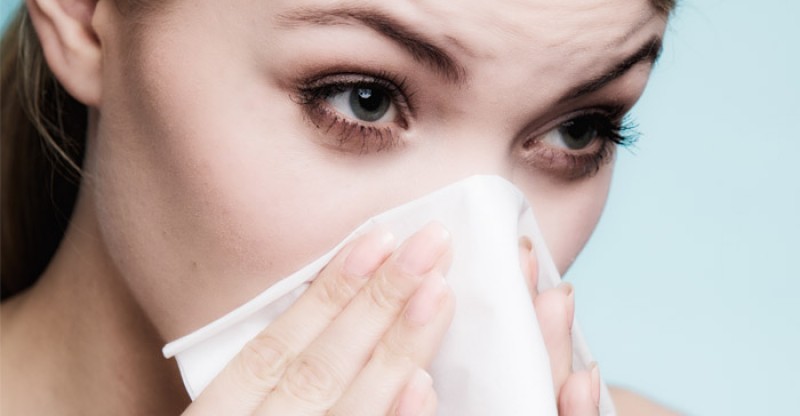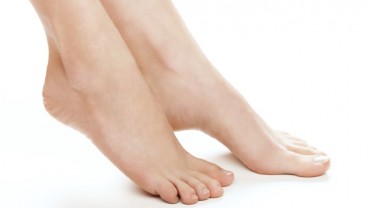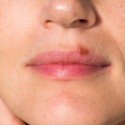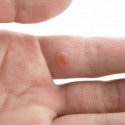How to Get Rid of Mucus – 22 Home Remedies
Maybe you’re sick, coughing up mucus, and have phlegm in throat.
Or you just can’t figure out how to get rid of a runny nose.
Either way, life can be very uncomfortable.
The human body is designed to get the nasty stuff out and destroy pathogens.
So the best home remedy for mucus relief may be to just let it run its course.
Mucus is actually a very important defense system.
It traps germs and expels them through a respiratory function called the ciliary elevator.
It produces phlegm that moves germs and irritants through your lower respiratory system, so they’ll be coughed up.
Mucus serves the same purpose, but it tends to rid your body of germs and irritants in your nose, head, ears, and mouth.
Since you probably can’t just lie in bed for 7-14 days until the illness passes, there are some ways to help relieve symptoms.
Then you can go on with your busy life.
If you simply can’t bear it anymore, just keep reading for some helpful hints about how to get rid of phlegm, mucus, and a runny nose.
Drink Plenty of Fluids
Yes, this combination — rest and fluids—is age-old because it has merit.
Your nasal passages secrete mucus to trap and expel invading germs.
When the delicate mucus membranes are dry, they’re constricted, so they can’t do their job.
Drinking plenty of fluids helps thin mucus secretions, and it makes you feel better.
Try hot water with lemon, herbal tea, and warm broth.
Avoid caffeine and alcohol; they constrict nasal passages, so they’ll just make you more uncomfortable.
Instead, drink liquids that contain antioxidants, which help fight illness.
Try Inhaling Steam
If you keep those delicate nasal passages (and the tissues in your mouth and throat) moist, it’ll help pass secretions and get rid of phlegm more easily.
If you taking a hot shower or bath when you wake up and before you go to bed, that’s also helpful.
Or you can pour some boiling water into a large bowl and lean over it.
You can also add essential oils or Himalayan salt if you have them.
Be sure you have plenty of tissues handy, because steam will quickly get rid of mucus and phlegm.
Blow Your Nose Effectively
When you blow your nose, be sure to use gentle pressure to protect your ears.
And gently expel mucus one nostril at a time — by holding the other closed.
Don’t blow too hard, or the pressure in your ears could burst the thin, pressurized membrane in your inner ear.
You could give also give yourself a bloody nose.
However, you could end up with a painful sinus infection if you don’t clear your nose whenever you feel the need.
So be sure to just tote a box of tissues around with you!
Don’t Suppress Cough
Coughing clears your lower respiratory system (your lungs) of mucus, which prevents pneumonia.
You may want to reach for a cough suppressant, but it’s best to let your body do its job and expel that mucus.
Studies actually show that cough syrup does little more than make you feel drowsy.
Then you’ll be so tired that you’ll sleep through your symptoms.
But it doesn’t actually prevent coughing.
And if you aren’t coughing up phlegm, it’ll remain in your lungs.
Be really careful with cough suppressants.
Consult a doctor if you feel you need to use one for more than a couple of nights.
Remember to cover your mouth with a tissue to keep any germs from spreading.
One hefty cough can send respiratory droplets ten feet away.
Wash Your Hands Frequently
Especially after blowing your nose or coughing up mucus, be sure to thoroughly wash your hands.
Then you’ll prevent spreading your germs around.
Viruses can mutate, so you could even re-infect yourself if you’re not careful.
The proper handwashing technique is to wet your hands with (preferably forcefully running) warm water, apply soap, vigorously scrub for 30 seconds, and thoroughly rinse (without rubbing your hands together).
Wash Away the Mucus with Nasal Irrigation
Nasal irrigation can be very helpful because it needs no prescription or over-the-counter medications.
This rinse will quickly get rid of mucus.
You’ll need to purchase a Neti pot and some saline solution (both of which are available online or in most drugstores).
Basically, you’re manually flushing out your nasal cavities.
Nasal irrigation provides instant relief, and it only takes a couple of minutes.
The idea is to fill one nostril with a warm, soothing, loosening saline solution.
Then drain it out through the other nostril.
This technique takes some getting used to, so don’t give up if it feels really weird or messy the first time.
Once you’re familiar with nasal irrigation, your days of having a runny nose and thick nasal secretions may be over.
As with any good thing, you can overdo nasal irrigation to the point that it’s no longer beneficial.
You don’t want to wash away the good bacteria of your natural flora, so read these tips on proper nasal irrigation.
Use a Cool Mist Humidifier
A key concept in the world of mucus and phlegm is moisture.
Indoor air can be particularly drying to the skin and mucus lining, which should always remain moist.
If the air you’re breathing is too dry, your mucus production can go into overdrive.
And that’ll wreak havoc on your ability to breathe comfortably and go about your normal routine.
In fact, ideal air moisture is 30-50% humidity, based on your personal preference and comfort level.
Some homes have a humidifying system connected to the furnace, which supplies moisture to the air that emerges from your vents in your home.
These systems need to be cleaned regularly to prevent a buildup of mold, but they do an amazing job of keeping the air inside your home comfortable.
If your home doesn’t have a humidifying system built into your furnace, you’ll be more comfortable with a portable humidifier that you can move around the house.
Then you can keep the air in your bedroom, office, or living room nice and moist.
Cool-mist humidifiers tend to be better at keeping mold formation to a minimum, but they must still be cleaned after each use.
Some high-end humidifiers have ultraviolet lights to kill mold and bacteria in the water tank.
There are several models that provide a small cup in front of the vapor port for adding essential oils, which cause freer breathing.
Here’s a good humidifier buying guide.
For a few dollars, you can pick up a hygrometer to keep tabs on the level of humidity in your home.
Remember that colder air holds less moisture.
So you may want to adjust the thermostat a few degrees warmer when you’re trying to create a more humid environment.
Try a Shower Bomb
A shower bomb is a disc made of baking soda, water, and essential oils (such as peppermint and eucalyptus).
A relatively simple idea, you just mix the ingredients together, and pour the mixture into an ice-cube tray or parchment cupcake liners.
Then let it dry.
You can find recipes to make the discs and search shower bomb decongestants here.
Make a batch and keep them in an airtight jar in your bathroom.
Then place one on the shower floor while you’re standing under the hot water.
The disc will melt away, releasing the essential oils and decongests.
Bonus: the baking soda will clean your shower drain!
You shouldn’t use these bombs in bathwater.
They’re just for releasing the oils into the air through shower water.
This tool could quickly get rid of a runny nose, but all of that mucus has to go somewhere.
So be prepared for a lot of nose-blowing after your shower.
Avoid Mucus-Causing Irritants
Cigarette smoke, smog, pet dander, mold, and other allergens can add to your discomfort.
Some people even have discomfort caused by candles, wax melts, scent diffusers, and incense.
To prevent further upper respiratory symptoms, avoid these irritants as much as possible.
If you tend to notice you have a lot of mucus and phlegm during the warmer months (not just when the air is cold and dry) , you may want to talk to an allergist to see if irritants are a cause of your symptoms.
The Asthma and Allergy Foundation of America has a helpful article on the subject of mucus and allergens.
Elevate Your Head while You Sleep
If your symptoms seem to get worse at night while you’re trying to sleep, “a lot of that has to do with positioning,” says Jennifer Collins, MD (an assistant professor of allergy and immunology at The New York Eye and Ear Infirmary).
“When you’re sitting up, gravity is helping you.
When you lie flat, that post-nasal drip starts pulling on the back of your throat, making it much more difficult to breathe through your nose.
Most people end up breathing through their mouth and coughing, which is disruptive to sleep.”
Read more from Dr. Collins here.
However, simply stuffing another pillow under your head could give you a sore neck by morning.
You can either slide a foam wedge under your mattress to lift the head of your bed.
Or to form a soft wedge, tuck one extra pillow under your shoulders, and two pillows under your head.
This elevation will help your nasal passages drain while you sleep.
And it’ll help you stay asleep with less coughing and irritation from phlegm and mucus.
Use a Vapor Rub
Vapor rubs come in menthol, cherry, eucalyptus, lemon, or lavender.
You can rub this thick ointment from a jar onto your chest, and it’ll open your nasal passages and clear out your sinuses while you sleep.
This remedy is tried and true, especially for those times when you have so much mucus you just can’t even breathe.
Some people even swear by a layer on their feet with a pair of thick socks.
You can also find the vapor rub in a roll-on package that’s much easier to carry with you when you’re at work or on the go.
You can make your own vapor rub with simple ingredients from your kitchen.
Inhale Essential Oils
Mint, lavender, eucalyptus, rosemary, and chamomile are all known to have wonderful properties that help get rid of a runny nose and phlegm in your throat.
To release the essential oils into the air, you’ll need an oil diffuser, or simply pour a few drops into your humidifier.
Some herbs can be irritating, and others may bother children.
So be sure you’re using the right combination for your symptoms and age.
Try this recipe to clear up nasal congestion fast:
2 Drops Eucalyptus Oil
2 Drops Thyme Oil
3 Drops Peppermint Oil
3 Drops Rosemary Oil
You can place these oils in a diffuser on your desk or nightstand.
Or place them in a bowl of boiling water for steam inhalation.
Gargle with Saltwater
A simple, effective technique for getting rid of phlegm in your throat is basic gargling.
Saltwater is an antiseptic, so it kills germs and loosens thick mucus secretions.
Simply dissolve half a teaspoon of sea salt in warm water, put it in your mouth, tip your head back, gargle as long as possible, and spit into the sink.
This method of manually removing mucus is a good idea.
While mucus can be good for destroying bacteria and viruses, pathogens can hide in it.
And of course, you’ll feel much better when all of the gunk is cleared out of your throat.
Just a Spoonful of Honey
Especially useful right after gargling, the antibiotic and soothing properties of honey make it a great home remedy for mucus relief.
For the best results, use a good-quality raw honey.
Remember, children under the age of 2 should never consume raw honey because of the risk of botulism.
But it has amazing, natural healing properties for older kids and adults.
In fact, locally produced honey can help with allergies, which often contribute to excess mucus production.
So pick up some local raw honey, and just swallow a tablespoon to let it coat your throat.
It also soothes sore throats.
Get the Right Massage
The body’s lymph system is the natural drainage system of the body.
When it gets clogged up, you can suffer from excess mucus production, which could lead to sinus and ear infections.
So find a massage therapist in your area who’s experienced with lymph drainage.
A massage is incredibly relaxing, and it’ll manually help you expel excess mucus.
A therapist properly trained in lymph drainage knows how to effectively push mucus from areas causing congestion without the use of medications.
If you can’t book a massage, check out these tips for self-massage.
Avoid Foods that Cause Mucus
Milk, eggs, seafood, cheese, and high-fat foods can all contribute to mucus production.
Change your diet a little, and see if some adjustments bring you relief.
Make it Spicy
Using spices in the soups, broths, and other foods you consume while you’re sick can help loosen mucus secretions.
Thanks to the chemical properties of capsaicin (which give peppers their heat), chili peppers will spice things up and thin out nasal secretions.
Also beneficial are cinnamon, clove, oregano, and garlic — all of which actually prohibit bacterial growth.
Get Plenty of Rest
When you’re active, your respiratory system has to work harder, which can be tough on a compromised system.
Resting allows your body to heal, so be sure you’re getting a full night’s sleep.
And even take daytime naps if you can.
But Still Exercise
Though it seems contradictory, a little exercise is good to get your blood pumping and give your lungs a workout.
But don’t go for a five-mile run.
Just take a light walk or do a little yoga.
Remember to replace fluids lost during exercise, and allow yourself to rest afterward.
When mucus starts to build up, you’ll probably notice sinus pressure.
This article explains how exercise can help combat the sinus pressure from mucus buildup.
Enjoy Frozen Treats
Although ice cream is milk-based (so it could actually contribute to mucus production), frozen fruit bars will feel good if your throat is sore from coughing up phlegm.
Just Breathe
There’s some science behind careful breathing techniques.
If you like the idea of being able to combat your symptoms anywhere (and without any special equipment), they might be worth checking out.
Basically, you’ll learn how to shorten your breaths by utilizing nasal and abdominal breathing.
The technique is said to help with excess phlegm and mucus production — 2-10 times faster than any other remedy.
Eat Chicken Soup
Why is chicken soup the remedy for everything?
Well, it actually does a number of wonderful things for the human body.
When you’re not feeling well, the last thing you want to worry about is a well-balanced meal.
All of that cutting, chewing, and sitting at the table just doesn’t sound good when you’re all congested.
But chicken soup is sneaky!
It packs a ton of protein in the bite-size pieces of chicken.
And it provides a full serving of vegetables (such as carrots, celery, and onions).
And the broth is an electrolyte solution that’s great for hydrating.
The heat of the soup helps thin nasal secretions as well.
FDA Compliance
The information on this website has not been evaluated by the Food & Drug Administration or any other medical body. We do not aim to diagnose, treat, cure or prevent any illness or disease. Information is shared for educational purposes only. You must consult your doctor before acting on any content on this website, especially if you are pregnant, nursing, taking medication, or have a medical condition.
HOW WOULD YOU RATE THIS ARTICLE?





